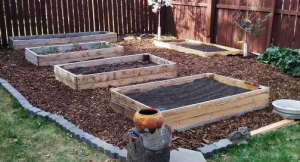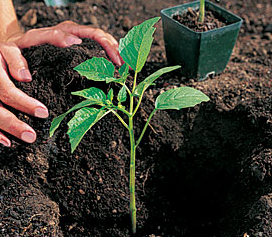MORE Raised Garden Beds
Soil Depth & Plant Arrangement
The depth of the raised bed depends on whether or not the soil underneath is in good condition as well as the rooting requirements of the crops within it. Also the placement of the bed should be taken into consideration. If you don’t have the space in the yard, you can build a raised bed for use on cement or gravel, just be sure that appropriate drainage is allowed and the bed is high enough for the root systems of your intended crops.

Preparing Ground under Raised Garden Beds
Raised garden beds, regardless of size, typically have open bottoms to allow access to the soil nutrients from the ground below. It’s important to dig at least two shovel blades or 24″ down while loosening the soil and removing all the rocks and debris. This process is much easier when completed before the beds are in place.
If needed, you can improve the condition of the ground soil by adding peat moss or compost to the soil. Rock phosphate can also be sprinkled on the surface before the bed is topped up.
Tips for Constructing the Raised Bed Garden
The most popular height for raised beds is 11″, two standard “2 x 6″ boards. This height provides sufficient drainage for most crops. For best results, there should be another 12″ or more of good soil below the bed. This gives your plants at least 18 – 20″ of soil that will warm quicker than the grounds subsoil so you can plant earlier.
If you are worried about mobility, raising the bed up to 24″ can give you easier access for tilling, transplanting, weeding, thinning, adding mulch and harvesting. For those confined to a wheelchair, an elevated planter is another option, though crops may need staking or tying to a trellis, as well as appropriate drainage.
If the bed is taller than 12” and longer than 6′, it will likely require a cross-support in the centre of the span, across the width of the bed, to keep the sides from bowing due to the heavier weight of the soil and water inside. The cross-support can be made using wood, composite plastic or aluminum.
Popular Vegetables and Soil Depth
When preparing a garden bed for planting, you must take into account the root depth of the vegetable crop being seeded or transplanted, this will help you decide which crops to plant and how deeply the soil is prepared. For example, plant shallow rooted crops like lettuce or radishes in beds where the ground soil has more clay and does not drain well or if putting your raised bed on cement or gravel.
Larger vegetable plants will grow deeper roots and will need the extra ground soil if the bed isn’t constructed high enough. When plants send their roots deeper, they are less likely to fall over in windy conditions or if the ground becomes too soggy. Large-leafed but shallow-rooted plants such as broccoli, brussels sprouts and cauliflower may require staking to help keep them upright as they grow to maturity.
Shallow Roots 12″ – 18″: Arugula, Bok Choy, Broccoli, Brussels Sprouts, Cabbage, Cauliflower, Celery, Chinese Cabbage, Chives, Corn, Endive, Garlic, Leeks, Lettuce, Onions, Potatoes, Radishes, Spinich, Strawberries
Medium Roots 18″ – 24″: Beans (dry, pole, snap), Beets, Canteloupe, Carrots, Chard, Cucumber, Eggplant, Kale, Peas, Peppers, Rutabagas, Summer Squash, Turnips
Deep Roots 24″-36″+: Artichokes, Asparagus, Lima Beans, Okra, Parsnips, Pumpkins, Rhubarb, Sweet potatoes, Tomatoes, Watermelon, Winter Squash
Plant Arrangement and Maturity
When laying out a raised bed garden, it’s wise to plant one crop per bed. The beds should be oriented to face south and be arranged horizontally. This optimizes sun exposure from side to side across the bed, and keeps neighbouring plants from shading each other as the sun moves east to west. This will make harvesting easier and the soil can be completely cleared out and planted in a green manure crop or mixed in compost to restore it’s nutrients for recycled use.
It is important to know how tall each crop will reach at maturity as you don’t want some of your plants blocking others from the sun. Shorter plants like lettuce and radishes should be planted on the south side of the beds, with mid-size plants behind, and the tallest plants to the rear (north) of the planted area. Tall plants on a trellis like pole beans and peas will block a lot of light, so it’s best to keep trellis to the rear as well, or away from the beds all together.
Wind is another factor to consider. Taller plants are more vulnerable to wind damage so they may need to be staked, secured to a trellis, or planted next to a windbreak. Plants get much heavier with fruit, so trellises need to be well secured.
Here is a chart that lists popular crops and their size at maturity:
| Artichoke | 4′ – 5′ |
| Arugula | 8″ – 10″ |
| Asparagus | 4′ – 6′ |
| Beans, bush | 24″ – 30″ |
| Beans, lima (bush) | 24″ – 36″ |
| Beans, pole | 8′ – 12′ |
| Beets | 4″ – 12″ |
| Broccoli | 18″ – 24″ |
| Brussels sprouts | 24″ – 36″ |
| Cabbage | 12″ – 18″ |
| Carrots | 6″ – 15″ |
| Cauliflower | 12″ – 30″ |
| Celery | 18″ – 24″ |
| Chard | 12″ – 30″ |
| Chinese cabbage | 12″ – 24″ |
| Corn | 4′ – 8′ |
| Cucumber | 1′ – 5′ |
| Eggplant | 1′ – 3′ |
| Endive | 6″ – 9″ |
| Garlic | 12″ – 24″ |
| Kale | 12″ – 24″ |
| Kohlrabi | 9″ – 12″ |
| Leeks | 12″ – 24″ |
| Lettuce | 6″ – 12″ |
| Okra | 2′ – 8′ |
| Onions | 8″ – 24″ |
| Parsnips | 6″ – 18″ |
| Peas | 2′ – 6′ |
| Peppers, hot | 12″ – 48″ |
| Peppers, bell | 24″ – 36″ |
| Potatoes | 12″ – 30″ |
| Pumpkin | 12″ – 24″ |
| Radishes | 2″ – 6″ |
| Rhubarb | 12″ – 36″ |
| Rutabaga | 12″ – 18″ |
| Spinach | 6″ – 15″ |
| Squash, summer | 12″ – 24″ |
| Squash, winter | 12″ – 24″ |
| Sweet potato | 12″ – 30″ |
| Tomatoes | 2′ – 8′ |
| Turnips | 6″ – 12″ |
| Watermelon | 12″ – 36″ |



